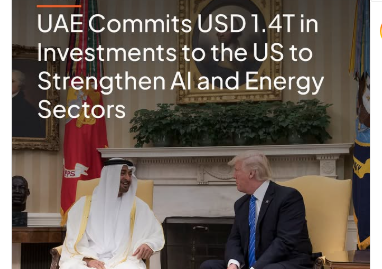One startling number—$1.4 trillion—has been making headlines in the world of finance in recent days. That is the magnitude of the UAE’s ten-year investment commitment to the US, a financial framework that is a declaration of intent rather than just a catchphrase. This capital infusion, which is remarkably situated at the nexus of manufacturing, AI, and energy, is about guiding the future rather than just making money.
The UAE demonstrated a clear goal by meeting with U.S. officials, including national security adviser Sheikh Tahnoon bin Zayed, and former President Donald Trump: to integrate its economic future with America’s industrial and technological revival. This Gulf country is turning capital into a tool of innovation, diplomacy, and long-term relevance through strategic alliances and sovereign wealth initiatives.
UAE-U.S. Investment Framework Snapshot
| Attribute | Details |
|---|---|
| Total Investment | $1.4 Trillion over 10 Years |
| Key Sectors | AI Infrastructure, Semiconductors, Energy, Manufacturing |
| Notable Projects | $25B ADQ-Energy Capital Data Infra |
| Natural Gas Expansion | XRG (ADNOC) investing in NextDecade LNG facility in Texas |
| AI Mega Initiative | Up to $100B co-investment (NVIDIA, Microsoft, BlackRock, xAI) |
| Strategic Motivation | Diversification from Oil |
| Authentic Source | Reuters Coverage on UAE Investment |
A Financial Power as Accurate as a System Guided by Laser
This framework’s thematic alignment with industries that are both geopolitically strategic and future-proof is what makes it so novel. By making investments in semiconductors and AI infrastructure, which are essentially the new oil, the UAE is establishing itself as a superpartner for the digital age.
This framework is exceptionally successful at scaling critical industries and promoting cross-border innovation at the same time because of its partnerships with U.S.-based companies like Energy Capital Partners and infrastructure behemoths like NVIDIA and xAI. The UAE gains technical know-how while avoiding political backlash by partnering instead of just purchasing.
AI, Aluminum, and America’s Resurrection
Emirates Global Aluminium’s decision to construct the first new U.S. smelter in 35 years is not merely symbolic; it is remarkably clear in its intent in a world where supply chains are vulnerable and domestic production is viewed as a security concern. By almost doubling aluminum production, this project supports industries ranging from aerospace to construction and fortifies America’s industrial core.
The $25 billion data infrastructure partnership, which aims to construct next-generation AI facilities, is comparable to the early internet’s fiber optic cable installation. These investments are laying the groundwork for future technological advancements in addition to meeting current demand.
From Exports of Energy to Dominance in Digital
The UAE has gradually transitioned from dominance in oil exports to high-tech investment diplomacy over the last ten years. A notable layer of symmetry is added by the ADNOC-backed XRG’s dedication to American natural gas infrastructure: American infrastructure helps the UAE achieve its diversification objectives, while Gulf gas supports American industry.
This duality produces a geopolitical loop of benefit through strategic alliances. It is especially advantageous for the United States, which raises money without giving up control, and the United Arab Emirates, which expands its influence internationally beyond hydrocarbons.
A Multibillion-Dollar Venture for Uncommon Resources
Access to rare earths and essential minerals is an existential problem in the context of the global digital revolution, not just an economic one. ADQ and Orion Resource Partners have invested $1.2 billion in U.S. mining projects to increase domestic access to materials like cobalt and lithium, which will power clean energy grids, advanced batteries, and electric cars.
Because it incorporates environmental standards, local job creation, and tech-enabled traceability—elements that make it both politically sustainable and commercially competitive—this play is noticeably better than traditional extraction deals.
Why This Isn’t Just Another Gulf Checkbook Moment: Diplomacy Meets Data
In contrast to earlier Gulf investments that focused on real estate or military hardware, this project integrates the UAE into the backbone of the American economy. Through coast-to-coast infrastructure projects and AI co-investment with companies like Microsoft and BlackRock, the capital of the United Arab Emirates becomes a co-author of U.S. industrial policy.
This model is incredibly durable in addition to being very efficient. The UAE is not placing its bets on a single industry by distributing its influence across sectors. In order to create a network effect that might outlast any one administration, it is diversifying across the tech, energy, and industrial trifecta.
From Meeting Rooms to Worldwide Repercussions
This investment plan was developed in the Oval Office and refined over private dinners between U.S. policymakers and UAE leadership; it did not originate from a press release. These high-stakes discussions highlight how closely finance and foreign policy have become intertwined, reflecting the accuracy of private equity negotiations rather than conventional state diplomacy.
Anticipate that this $1.4 trillion plan will impact global regulatory frameworks, R&D funding, educational pipelines, and market indices in addition to GDPs and market indices in the years to come. Because capital doesn’t simply follow the market when it moves at this scale and with this degree of specificity. It molds it.


